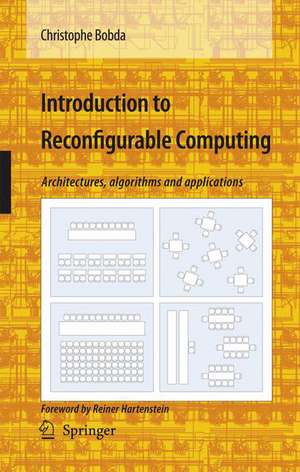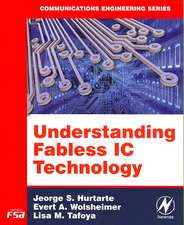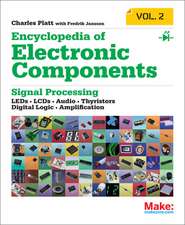Introduction to Reconfigurable Computing: Architectures, Algorithms, and Applications
Autor Christophe Bobdaen Limba Engleză Hardback – 15 oct 2007
- Architecture of reconfigurable systems, which presents the technology and the architecture used in fined-grained and those used in coarse-grained reconfigurable devices.
- Design and implementation: This section deals with the implementation on reconfigurable system. It briefly covers the steps needed to implement application on today's FPGAs. And focus on the logic synthesis for FPGA, in particular LUT technology mapping.
- High-Level Synthesis for Reconfigurable Devices: The high-level synthesis for reconfigurable systems, also known as temporal partitioning is presented here. Several temporal partitioning techniques are presented and explained.
- Temporal placement: This section considers stand alone reconfigurable systems. Its assume that a kind of operating systems for reconfigurable systems is in charge of managing the resources of a given system and allocate space on a device for the computation of incoming tasks., and therefore presents several temporal placement approaches for off-line as well as on-line placement.
- On-line and Dynamic Interconnection: This chapter reviews andexplains the different approaches for allowing communication between modules dynamically placed at run-time on a given device.
- Designing a reconfigurable application on Xilinx Virtex FPGA: In this section, the different design approaches of partial reconfigurable systems on the Xilinx FPGAs that are one of the few one on the market with this feature, is explained.
- System on programmable chip: System on programmable chip is a hot topic in reconfigurable computing. This is mainly the integration of a system made upon some peripheral (UART, Ethernet, VGA, etc.), but also computational (Coding, filter, etc.) hardware modules on one programmable chip. The current usable solutions are presented: The book furthermore focusses on the development of adaptive multiprocessors on chip, i.e. systems consisting of a set of Processors and exchangeable hardware accelerators.
- Applications: This part covers the use of reconfigurable system in computer architecture (rapid prototyping, reconfigurable supercomputer, reconfigurable massively parallel computers) and algorithm better adapted for reconfigurable systems (distributed arithmetic, network packet processing, etc...)
| Toate formatele și edițiile | Preț | Express |
|---|---|---|
| Paperback (1) | 644.82 lei 6-8 săpt. | |
| SPRINGER NETHERLANDS – 19 oct 2010 | 644.82 lei 6-8 săpt. | |
| Hardback (1) | 653.33 lei 6-8 săpt. | |
| SPRINGER NETHERLANDS – 15 oct 2007 | 653.33 lei 6-8 săpt. |
Preț: 653.33 lei
Preț vechi: 768.62 lei
-15% Nou
Puncte Express: 980
Preț estimativ în valută:
125.03€ • 135.76$ • 105.02£
125.03€ • 135.76$ • 105.02£
Carte tipărită la comandă
Livrare economică 23 aprilie-07 mai
Preluare comenzi: 021 569.72.76
Specificații
ISBN-13: 9781402060885
ISBN-10: 1402060882
Pagini: 359
Ilustrații: XXV, 359 p.
Dimensiuni: 155 x 235 x 21 mm
Greutate: 0.78 kg
Ediția:2007
Editura: SPRINGER NETHERLANDS
Colecția Springer
Locul publicării:Dordrecht, Netherlands
ISBN-10: 1402060882
Pagini: 359
Ilustrații: XXV, 359 p.
Dimensiuni: 155 x 235 x 21 mm
Greutate: 0.78 kg
Ediția:2007
Editura: SPRINGER NETHERLANDS
Colecția Springer
Locul publicării:Dordrecht, Netherlands
Public țintă
ResearchCuprins
Reconfigurable Architectures.- Implementation.- High-Level Synthesis For Reconfigurable Devices.- Temporal Placement.- Online Communication.- Partial Reconfiguration Design.- System On A Programmable Chip.- Applications.
Recenzii
The book by Christophe Bobda, however, has also been written for people with a software background, substantially reducing the educational leap by bridging the gap. His book has the potential to become a best-seller and to stimulate the urgently needed transformation of the software developer population’s mind set, by playing a similar role as known from the famous historic Mead-&-Conway textbook for the VLSI design revolution.
Reiner Hartenstein, IEEE fellow,
Professor, TU Kaiserslautern "
Reiner Hartenstein, IEEE fellow,
Professor, TU Kaiserslautern "
Notă biografică
Dr. Christophe Bobda is Associate Professor in the Department of Computing Science at Kaiserslautern University of Technology in Germany
Textul de pe ultima copertă
“Introduction to Reconfigurable Computing” provides a comprehensive study of the field Reconfigurable Computing. It provides an entry point to the novice willing to move in the research field reconfigurable computing, FPGA and system on programmable chip design. The book can also be used as teaching reference for a graduate course in computer engineering, or as reference to advance electrical and computer engineers. It provides a very strong theoretical and practical background to the field of reconfigurable computing, from the early Estrin’s machine to the very modern architecture like coarse-grained reconfigurable device and the embedded logic devices. Apart from the introduction and the conclusion, the main chapters of the book are the following:
-Architecture of reconfigurable systems, which presents the technology and the architecture used in fine-grained and those used in coarse-grained reconfigurable devices.
-Design and implementation: This section deals with the implementation on reconfigurable system. It briefly covers the steps needed to implement application on today's FPGAs. And focus on the logic synthesis for FPGA, in particular LUT technology mapping.
-High-Level Synthesis for Reconfigurable Devices: The high-level synthesis for reconfigurable systems, also known as temporal partitioning is presented here. Several temporal partitioning techniques are presented and explained.
-Temporal placement: This section considers stand alone reconfigurable systems. Its assume that a kind of operating systems for reconfigurable systems is in charge of managing the resources of a given system and allocate space on a device for the computation of incoming tasks., and therefore presents several temporal placement approaches for off-line as well as on-line placement.
-On-line and Dynamic Interconnection: This chapter reviews and explains the different approaches for allowing communication between modules dynamicallyplaced at run-time on a given device.
-Designing a reconfigurable application on Xilinx Virtex FPGA: In this section, the different design approaches of partial reconfigurable systems on the Xilinx FPGAs that are one of the few on the market with this feature, are explained.
-System on programmable chip: System on programmable chip is a hot topic in reconfigurable computing. This is mainly the integration of a system made upon some peripheral (UART, Ethernet, VGA, etc.), but also computational (Coding, filter, etc.) hardware modules on one programmable chip. The current usable solutions are presented: The book furthermore focuses on the development of adaptive multiprocessors on chip, i.e. systems consisting of a set of Processors and exchangeable hardware accelerators.
-Applications: This part covers the use of reconfigurable system in computer architecture (rapid prototyping, reconfigurable supercomputer, reconfigurable massively parallel computers) and algorithm better adapted for reconfigurable systems (distributed arithmetic, network packet processing, etc...).
-Architecture of reconfigurable systems, which presents the technology and the architecture used in fine-grained and those used in coarse-grained reconfigurable devices.
-Design and implementation: This section deals with the implementation on reconfigurable system. It briefly covers the steps needed to implement application on today's FPGAs. And focus on the logic synthesis for FPGA, in particular LUT technology mapping.
-High-Level Synthesis for Reconfigurable Devices: The high-level synthesis for reconfigurable systems, also known as temporal partitioning is presented here. Several temporal partitioning techniques are presented and explained.
-Temporal placement: This section considers stand alone reconfigurable systems. Its assume that a kind of operating systems for reconfigurable systems is in charge of managing the resources of a given system and allocate space on a device for the computation of incoming tasks., and therefore presents several temporal placement approaches for off-line as well as on-line placement.
-On-line and Dynamic Interconnection: This chapter reviews and explains the different approaches for allowing communication between modules dynamicallyplaced at run-time on a given device.
-Designing a reconfigurable application on Xilinx Virtex FPGA: In this section, the different design approaches of partial reconfigurable systems on the Xilinx FPGAs that are one of the few on the market with this feature, are explained.
-System on programmable chip: System on programmable chip is a hot topic in reconfigurable computing. This is mainly the integration of a system made upon some peripheral (UART, Ethernet, VGA, etc.), but also computational (Coding, filter, etc.) hardware modules on one programmable chip. The current usable solutions are presented: The book furthermore focuses on the development of adaptive multiprocessors on chip, i.e. systems consisting of a set of Processors and exchangeable hardware accelerators.
-Applications: This part covers the use of reconfigurable system in computer architecture (rapid prototyping, reconfigurable supercomputer, reconfigurable massively parallel computers) and algorithm better adapted for reconfigurable systems (distributed arithmetic, network packet processing, etc...).
Caracteristici
Architecture of Reconfigurable Systems: Exhaustive description of existing reconfigurable architectures, from the simple PLDs to very complex FPGAs and coarse-grained technologies Low-level Synthesis of reconfigurable devices (RD): State of the art algorithms for FPGA synthesis, in particular for the Look-up table technology mapping High-level synthesis (HLS): Detailed presentation of high-level synthesis approaches for reconfigurable device. Description of the fundamental difference between HLS for reconfiguration and the general HLS Temporal Placement: Algorithms for off-line and for on-line temporal placement with various goals like the efficient computation, efficient resource usage and On-line Communication: State of the art approaches for realizing dynamic communication paths between components dynamic placed on the chip at run-time Partial reconfiguration design: various approaches for designing partial reconfigurable systems on Xilinx FPGAs: tutorial–like presentation of the approaches Applications: Applications that may benefit from the use of reconfigurable device are pointed out and the use of reconfiguration to improve the systems is presented
















